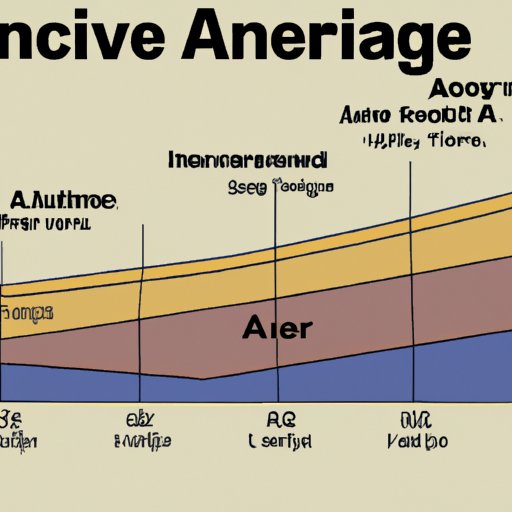Introduction
The average American income is an important indicator of economic well-being in the United States. It’s estimated that the median household income in 2020 was approximately $68,703. But what does it mean to be “average” when it comes to income? And how much does the average American make a year?
In this article, we’ll explore the definition of average American income, compare average American income by state, examine the cost of living and its impact on wages, look at the factors that influence average American income, discuss the relationship between education and income, investigate the gender pay gap and its effects on wages, and finally, analyze the historical trends in average American income and forecast the future of American wages.
A Comparison of Average American Income by State
When it comes to understanding average American income, it’s important to take into account the variations in wages based on geographic location. According to the Bureau of Labor Statistics, the median annual wage for all occupations in the U.S. was $41,950 as of May 2019. However, the median income varies significantly by state. For example, the median income in California was $61,400 while the median income in Mississippi was only $37,800.
So, what causes these variations in average American income by state? The main factor is the cost of living. For example, the cost of living in California is higher than in Mississippi, which means wages must also be higher to cover the higher costs of living. Other factors that contribute to variations in average American income include education levels, industry mix, and job market competition.
How the Cost of Living Impacts Average American Income
The cost of living refers to the amount of money needed to purchase basic goods and services. This includes items such as housing, food, utilities, transportation, healthcare, and other essential expenses. The cost of living can vary significantly from one region to another. For example, the cost of living in San Francisco is much higher than in Tulsa, Oklahoma.
Because the cost of living impacts wages, it follows that the cost of living affects average American income. As the cost of living increases, wages must also increase to keep up with the cost of basic goods and services. This means that areas with higher costs of living tend to have higher wages, while areas with lower costs of living tend to have lower wages.

Understanding the Factors That Influence Average American Income
In addition to the cost of living, there are several other factors that influence average American income. These include education levels, job market competition, and regional differences. Let’s take a closer look at each of these factors.
Education and Job Market
Education levels play a major role in determining average American income. Those with higher levels of education tend to earn higher wages. This is because those with higher levels of education tend to have better job opportunities and higher paying positions.
Job market competition also plays a role in average American income. Regions with higher levels of job market competition tend to offer higher wages to attract top talent. Conversely, regions with lower levels of job market competition tend to offer lower wages.
Location/Region
Location and region also have an impact on average American income. Certain cities and states tend to have higher wages than others, due to various factors such as the cost of living and job market competition. For example, New York City and California tend to offer higher wages than other parts of the country.
Gender/Age Discrimination
Gender and age discrimination can also play a role in average American income. Studies have shown that women and older workers tend to earn lower wages than their male and younger counterparts. This is due to a variety of factors, including unconscious bias and pay discrimination.
The Impact of Education on Average American Income
Education can have a huge impact on average American income. According to the US Census Bureau, individuals with a bachelor’s degree earn an average of $64,894 per year, while those with a high school diploma earn an average of $37,817 per year. This difference in wages is due to the fact that those with higher levels of education tend to have better job opportunities and higher paying positions.
Furthermore, certain types of degrees can lead to higher wages. For example, individuals with degrees in engineering, computer science, and business administration tend to earn higher wages than those with degrees in the humanities or social sciences.
In addition to higher wages, individuals with higher levels of education tend to have greater job stability and more career opportunities. Higher education can also help individuals develop new skills and knowledge that can be beneficial in the workplace.

Exploring the Gender Pay Gap and Average American Income
Another factor that influences average American income is the gender pay gap. According to the Institute for Women’s Policy Research, women in the US earn 82 cents for every dollar earned by men. This means that women earn an average of $10,086 less than men per year. The gender pay gap has a significant impact on average American income, as it leads to lower wages for women.
The gender pay gap exists due to a variety of factors, including conscious and unconscious bias, occupational segregation, and pay discrimination. To reduce the gender pay gap and increase average American income, efforts must be made to create fairer workplaces and eliminate discrimination.

Examining the Relationship Between Age and Average American Income
Age can also play a role in average American income. According to a report from the Economic Policy Institute, workers aged 55 and older earn an average of $22.29 per hour, while those aged 16-24 earn an average of $12.63 per hour. This difference in wages is due to a variety of factors, including experience, education level, and age discrimination.
Age discrimination can have a significant impact on average American income. Older workers are often overlooked for promotions and raises, leading to lower wages. In addition, some employers may refuse to hire older workers due to outdated beliefs about their abilities or potential contributions.

An Overview of Average American Income Over Time
Finally, it’s important to consider the historical trends in average American income. According to the US Census Bureau, the median household income in the US has increased steadily since 1967, when it was $9,870. By 2018, the median household income had reached $61,372. This shows that average American income has been on the rise over the past few decades.
Looking ahead, experts predict that average American income will continue to increase. According to a study by the Pew Research Center, the median household income is expected to reach $70,000 by 2030. This suggests that average American incomes will continue to rise in the years to come.
Conclusion
The average American income is an important indicator of economic well-being in the United States. This article has explored the definition of average American income, compared average American income by state, examined the cost of living and its impact on wages, looked at the factors that influence average American income, discussed the relationship between education and income, investigated the gender pay gap and its effects on wages, and analyzed the historical trends in average American income and forecast the future of American wages.
It’s clear that the cost of living, education levels, job market competition, gender and age discrimination, and other factors all have an impact on average American income. Understanding these factors is key to understanding the current state of average American income and predicting future trends.
(Note: Is this article not meeting your expectations? Do you have knowledge or insights to share? Unlock new opportunities and expand your reach by joining our authors team. Click Registration to join us and share your expertise with our readers.)
